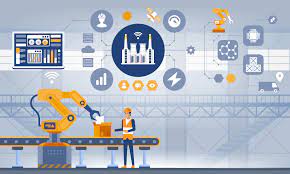Blockchain technology has gained attention for its potential application in IoT (Internet of Things) applications. Here’s how blockchain can be utilized in IoT data analytics and visualization:
- Data Integrity and Security:
Blockchain provides a distributed and immutable ledger, allowing IoT devices to securely store and verify data transactions. In IoT applications, where data integrity and security are paramount, blockchain can ensure that data remains tamper-proof and trustworthy. Each data transaction is recorded in a block, cryptographically linked to the previous blocks, making it extremely difficult to alter or manipulate the data. - Trust and Transparency:
Blockchain brings transparency to IoT data by enabling all participants in a network to access and validate the data. It creates a decentralized and trustless environment where data can be shared and verified without relying on a central authority. This transparency fosters trust among stakeholders, as they can independently verify the origin, integrity, and accuracy of the IoT data. - Data Provenance and Auditability:
Blockchain enables the tracking and auditing of IoT data throughout its lifecycle. Each data transaction is recorded, providing an auditable trail of data provenance. This capability is valuable in supply chain management, where the origin and history of goods can be traced, or in regulatory compliance, where data compliance and auditability are essential. - Smart Contracts for Automated Transactions:
Blockchain platforms often support smart contracts, which are self-executing contracts with predefined rules and conditions. In IoT applications, smart contracts can automate transactions and interactions between IoT devices or between devices and other entities. For example, a smart contract can automatically trigger a payment when specific conditions are met or enable devices to autonomously exchange data based on predefined rules. - Data Monetization and Ownership:
Blockchain can facilitate secure and transparent data monetization in IoT ecosystems. It allows IoT device owners to control and manage access to their data, granting permission to authorized parties while preserving data ownership rights. Blockchain-based marketplaces can facilitate fair and direct data exchange between data producers and consumers, eliminating intermediaries and ensuring data privacy and ownership. - Scalability and Consensus Mechanisms:
Scalability has been a challenge for blockchain networks, especially when dealing with the high volume and velocity of IoT data. However, advancements such as sharding, sidechains, and off-chain solutions are being explored to address scalability issues. Additionally, consensus mechanisms like Proof of Stake (PoS) or Directed Acyclic Graph (DAG) can improve the performance and efficiency of blockchain networks, making them more suitable for IoT data analytics.
Blockchain technology has the potential to revolutionize IoT (Internet of Things) applications by providing enhanced security, data integrity, and decentralized data management. Here are some key aspects of using blockchain for IoT applications:
- Enhanced Security: Blockchain provides a decentralized and immutable ledger that ensures the security and integrity of data exchanged between IoT devices. It eliminates the need for a central authority, reduces the risk of data tampering, and ensures that data is not altered or manipulated without consensus.
- Data Integrity and Traceability: Blockchain creates a transparent and auditable trail of all transactions or data exchanges in an IoT ecosystem. Each data entry, sensor reading, or transaction is recorded on the blockchain, allowing for traceability and verification of data from multiple sources.
- Improved Reliability and Resilience: Blockchain’s decentralized nature eliminates single points of failure by distributing data across multiple nodes. Even if some nodes fail or go offline, the data stored in the blockchain remains accessible, ensuring high reliability and resilience for IoT applications.
- Decentralized Data Management: Blockchain enables peer-to-peer interactions and data exchange between IoT devices without relying on a central server. This decentralized approach can reduce network congestion, latency, and dependency on cloud infrastructure, making IoT applications more scalable and efficient.
- Smart Contracts and Automation: Blockchain platforms often support the use of smart contracts, which are self-executing contracts with predefined rules and conditions. Smart contracts enable automation of transactions and data exchanges between IoT devices, reducing the need for manual intervention and streamlining processes.
Despite these benefits, there are some challenges associated with using blockchain for IoT applications:
- Scalability: Blockchain networks, especially public ones like Bitcoin or Ethereum, can face scalability issues when handling a large number of IoT device transactions. The consensus mechanisms and redundancy of storing data on all nodes can result in slow transaction processing and increased storage requirements.
- High Energy Consumption: Certain blockchain algorithms and consensus mechanisms, such as Proof of Work (PoW), require significant computational power and energy consumption. This can be a challenge, especially when IoT devices have limited power resources.
- Data Size and Storage: IoT devices generate massive amounts of data, and storing all data on a blockchain can become impractical and expensive. Balancing the need for data integrity and storage efficiency becomes crucial.
- Privacy and Confidentiality: While blockchain provides transparency and immutability, it presents challenges in terms of data privacy and confidentiality. Sensitive data in an IoT application may need to be protected from public visibility, requiring additional security measures or mechanisms for data encryption.
It’s important to note that deploying blockchain in IoT applications requires careful consideration of factors such as network connectivity, computational resources, latency constraints, and the balance between decentralization and efficiency. While blockchain brings benefits in terms of data integrity, security, and transparency, its adoption in IoT should be evaluated on a case-by-case basis, considering the specific requirements and constraints of the application.
